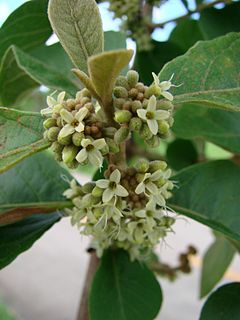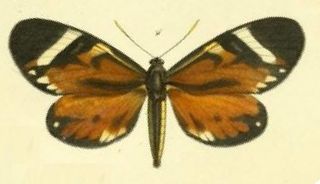
Classification of indigenous peoples of the Americas is based upon cultural regions, geography, and linguistics. Anthropologists have named various cultural regions, with fluid boundaries, that are generally agreed upon with some variation. These cultural regions are broadly based upon the locations of indigenous peoples of the Americas from early European and African contact beginning in the late 15th century. When indigenous peoples have been forcibly removed by nation-states, they retain their original geographic classification. Some groups span multiple cultural regions.

Oncidium, abbreviated as Onc. in the horticultural trade, is a genus that contains about 330 species of orchids from the subtribe Oncidiinae of the orchid family (Orchidaceae). As presently conceived, it is distributed across much of South America, Central America, Mexico and the West Indies, with one species (O. ensatum) extending into Florida. Common names for plants in this genus include dancing-lady orchid and golden shower orchid.

Castniidae, or castniid moths, is a small family of moths with fewer than 200 species: The majority are Neotropical with some in Australia and a few in south-east Asia. These are medium-sized to very large moths, usually with drab, cryptically-marked forewings and brightly coloured hindwings. They have clubbed antennae and are day flying, and are often mistaken for butterflies. Indeed, some previous classification systems placed this family within the butterflies or skippers. The Neotropical species are commonly known as giant butterfly-moths, the Australian and Asian species as sun moths. The larvae are internal feeders, often on roots of epiphytes or on monocotyledons.

Crypturellus is a genus of tinamous containing mostly forest species. However, there are the odd few that are grassland or steppe tinamous. There are 21 species of and a total of 67 taxa.

Tinamus is a genus of birds in the tinamou family. This genus comprises some of the larger members of this South American family.

Aegiphila is a genus of flowering plants in the mint family, Lamiaceae, first described in 1763. It was formerly classified in the Verbenaceae. It is native to Mexico, Central America, South America, the West Indies, and Florida.

Citharexylum is a genus of flowering plants in the verbena family, Verbenaceae. It contains shrub and tree species commonly known as fiddlewoods or zitherwoods. They are native to the Americas, ranging from southern Florida and Texas in the United States to Argentina. The highest diversity occurs in Mexico and the Andes. The generic name is derived from the Greek words κιθάρα (kithara), meaning "lyre", and ξύλον (xylon), meaning "wood," referring to the use of the wood in the sounding boards of string instruments. Several species, especially C. caudatum and C. spinosum, are cultivated as ornamentals.
- Citharexylum affineD.Don - from northern Mexico to Nicaragua
- Citharexylum alainiiMoldenke - Dominican Republic
- Citharexylum albicauleTurcz. - Cuba
- Citharexylum altamiranumGreenm. - northeastern Mexico
- Citharexylum andinumMoldenke - Bolivia, Jujuy Province of Argentina
- Citharexylum argutedentatumMoldenke - Peru
- Citharexylum berlandieriB.L. Rob. - from Texas to Oaxaca - Berlandier's fiddlewood, Tamaulipan fiddlewood
- Citharexylum bourgeauanumGreenm. - Veracruz, Oaxaca
- Citharexylum brachyanthum(A.Gray ex Hemsl.) A.Gray - Texas, Coahuila, Nuevo León - Boxthorn fiddlewood, Mexican fiddlewood
- Citharexylum bullatumMoldenke - Colombia
- Citharexylum calvumMoldenke - Quintana Roo
- Citharexylum caudatumL. - southern Mexico, West Indies, Central America, Colombia, Peru - Juniper berry
- Citharexylum chartaceumMoldenke - Peru, Ecuador
- Citharexylum cooperiStandl. - Costa Rica, Panama, Guatemala
- Citharexylum costaricenseMoldenke - Costa Rica, Nicaragua, Honduras
- Citharexylum crassifoliumGreenm - Chiapas, Belize, Guatemala, Honduras
- Citharexylum daniraeLeón de la Luz & F.Chiang - Revillagigedo Islands of Baja California
- Citharexylum decorumMoldenke - Colombia, Venezuela
- Citharexylum dentatumD.Don - Peru
- Citharexylum discolorTurcz. - Cuba, Hispaniola
- Citharexylum donnell-smithiiGreenm. - Oaxaca, Chiapas, Central America
- Citharexylum dryanderaeMoldenke - Colombia, Venezuela, Peru, Ecuador
- Citharexylum ekmaniiMoldenke - Cuba
- Citharexylum ellipticumMoc. & Sessé ex D.Don - Veracruz, Campeche, Tabasco; naturalized in Cuba + Cayman Islands
- Citharexylum endlichiiMoldenke - northeastern Mexico
- Citharexylum flabellifoliumS.Watson - Sonora, Baja California
- Citharexylum flexuosum(Ruiz & Pav.) D.Don - Bolivia, Peru
- Citharexylum fulgidumMoldenke - Veracruz, northeastern Mexico
- Citharexylum gentryiMoldenke - Ecuador
- Citharexylum glabrum(S.Watson) Greenm - Oaxaca
- Citharexylum glazioviiMoldenke - eastern Brazil
- Citharexylum grandiflorumAymard & Rueda - Ecuador
- Citharexylum guatemalense(Moldenke) D.N.Gibson - Guatemala, Nicaragua
- Citharexylum herreraeMansf. - Peru
- Citharexylum hexangulareGreenm. - from northern Mexico to Costa Rica
- Citharexylum hidalgenseMoldenke - Mexico
- Citharexylum hintoniiMoldenke - México State
- Citharexylum hirtellumStandl. - from Veracruz to Panama
- Citharexylum ilicifoliumKunth - Bolivia, Peru, Ecuador
- Citharexylum iltisiiMoldenke - Peru
- Citharexylum × jamaicenseMoldenke - Jamaica, Haiti, Puerto Rico (C. caudatum × C. spinosum)
- Citharexylum joergensenii(Lillo) Moldenke - Argentina, Bolivia
- Citharexylum karsteniiMoldenke - Colombia, Venezuela
- Citharexylum kerberiGreenm. - Veracruz
- Citharexylum kobuskianumMoldenke - Peru
- Citharexylum krukoviiMoldenke - eastern Brazil
- Citharexylum kunthianumMoldenke - Colombia, Venezuela, Ecuador
- Citharexylum laetumHiern - southern Brazil
- Citharexylum laurifoliumHayek - Bolivia, Peru
- Citharexylum lemsiiMoldenke - Guanacaste Province in Costa Rica
- Citharexylum × leonisMoldenke - Cuba (C. caudatum × C. tristachyum)
- Citharexylum ligustrifolium(Thur. ex Decne.) Van Houtte - Mexico
- Citharexylum lojenseMoldenke - Ecuador
- Citharexylum lucidumCham. & Schltdl. - Mexico
- Citharexylum lycioidesD.Don - Mexico
- Citharexylum macradeniumGreenm. - Panama, Costa Rica
- Citharexylum macrochlamysPittier - Panama, Colombia
- Citharexylum macrophyllumPoir. - Colombia, Venezuela, Ecuador, Guianas, northwestern Brazil
- Citharexylum matheanumBorhidi & Kereszty - Cuba
- Citharexylum matudaeMoldenke - Chiapas
- Citharexylum mexicanumMoldenke - Veracruz, Puebla, Oaxaca
- Citharexylum microphyllum(DC.) O.E.Schulz - Hisipaniola
- Citharexylum mirifoliumMoldenke - Colombia, Venezuela
- Citharexylum mocinoiD.Don - Mexico, Central America
- Citharexylum montanumMoldenke - Colombia, Ecuador
- Citharexylum montevidense(Spreng.) Moldenke - Brazil, Argentina, Paraguay, Uruguay
- Citharexylum myrianthumCham. - Brazil, Argentina, Paraguay
- Citharexylum obtusifoliumKuhlm - Espírito Santo
- Citharexylum oleinum Moldenke - Mexico
- Citharexylum ovatifoliumGreenm. - Mexico
- Citharexylum pachyphyllumMoldenke - Peru
- Citharexylum pernambucenseMoldenke - eastern Brazil
- Citharexylum poeppigiiWalp. - Colombia, Venezuela, Ecuador, Bolivia, Peru, Brazil
- Citharexylum punctatumGreenm. - Bolivia, Peru
- Citharexylum quercifoliumHayek - Peru
- Citharexylum quitenseSpreng. - Ecuador
- Citharexylum racemosumSessé & Moc. - Mexico
- Citharexylum reticulatumKunth - Ecuador, Peru
- Citharexylum rigidum(Briq.) Moldenke - Paraguay, southern Brazil
- Citharexylum rimbachiiMoldenke - Ecuador
- Citharexylum roseiGreenm. - Mexico
- Citharexylum roxanaeMoldenke - Baja California
- Citharexylum scabrumMoc. & Sessé ex D.Don - northern Mexico
- Citharexylum schottiiGreenm. - southern Mexico, Central America
- Citharexylum schulziiUrb. & Ekman - Hispaniola
- Citharexylum sessaeiD.Don - Mexico
- Citharexylum shreveiMoldenke - Sonora
- Citharexylum solanaceumCham. - southern Brazil
- Citharexylum spinosumL. – Spiny fiddlewood - West Indies, Panama, Venezuela, the Guianas; naturalized in India, Mozambique, Fiji, Bermuda
- Citharexylum stenophyllumUrb. & Ekman - Haiti
- Citharexylum steyermarkiiMoldenke - Veracruz, Chiapas, Guatemala
- Citharexylum suberosumLoes. ex Moldenke - Cuba
- Citharexylum subflavescensS.F.Blake - Colombia, Venezuela, Ecuador, Peru
- Citharexylum subthyrsoideumPittier - Colombia, Venezuela
- Citharexylum subtruncatumMoldenke - northwestern Brazil
- Citharexylum sulcatumMoldenke - Colombia
- Citharexylum svensoniiMoldenke - Ecuador
- Citharexylum teclenseStandl. - El Salvador
- Citharexylum ternatumMoldenke - Cuba
- Citharexylum tetramerumBrandegee - Valle de Tehuacán-Cuicatlán in Mexico
- Citharexylum tristachyumTurcz. – Threespike Fiddlewood - Cuba, Jamaica, Leeward Islands
- Citharexylum uleiMoldenke - Colombia, Peru, northwestern Brazil
- Citharexylum vallenseMoldenke - Colombia
- Citharexylum venezuelenseMoldenke - Venezuela
- Citharexylum weberbaueriHayek - Peru

Telchin licus, the banana stem borer, is a moth of the Castniidae family. It is native to South America, where it is found from Colombia, Venezuela and the Guianas, throughout the Amazon basin in Brazil and Peru. It has also been recorded as an introduced species in Hawaii.

Castniomera is a monotypic moth genus in the family Castniidae described by Constant Vincent Houlbert in 1918. Its single species, Castniomera atymnius, the giant butterfly-moth, was first described by Johan Wilhelm Dalman in 1824. It is known from Mexico through Central America to Venezuela.

Marpesia is a butterfly genus in the family Nymphalidae. The species of this genus are found in the Neotropical and Nearctic realms.
Eupalamides guyanensis is a moth in the Castniidae family. It is widely distributed in northern South America, from Venezuela to Guyana, Colombia and Brazil (Pará).
Castnia invaria is a moth in the family Castniidae. It is found in South America.
Athis fuscorubra is a moth in the Castniidae family. It is found in Trinidad, Peru, Ecuador and Venezuela. It is probably also found in the Colombian Amazonas and north-western and northern Brazil.
Athis palatinus is a moth in the Castniidae family. It is found from Mexico south to Peru and Brazil.
Hista fabricii is a moth in the Castniidae family. It is found in Brazil. It mainly occurs in the southern and south-eastern parts of the country, in areas of the Atlantic Forest.

Geyeria decussata is a moth in the Castniidae family.
Haemonides cronis is a moth in the Castniidae family. It is found in Mexico, Trinidad, Suriname, French Guiana, Brazil and Peru.

Duboisvalia cononia is a moth in the Castniidae family. It is found in Ecuador, Colombia, Peru and Brazil.

Duboisvalia simulans is a moth in the Castniidae family. It is found in Colombia, Bolivia, Venezuela, Peru and Brazil.














